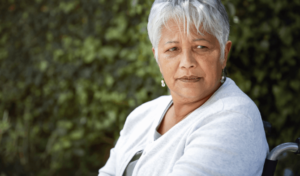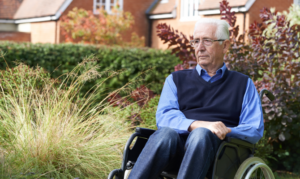What Are the Types of Elder Abuse?
Elder abuse is an intentional act or failure to act that harms or risks harming older adults, according to the Centers for Disease Control and Prevention (CDC).
Abuse often happens at the hands of caregivers or trusted individuals.
The elder abuse definition involves a broad range of harmful actions or neglect that affect older adults. This type of mistreatment can happen anywhere.
However, it is especially common in nursing homes and other long-term care facilities.
“Rates of abuse of older people are high in institutions such as nursing homes and long-term care facilities, with 2 in 3 staff reporting that they have committed abuse in the past year.”
—World Health Organization (WHO)
All types of elder abuse can lead to devastating consequences, including physical and/or emotional harm and even death.
Take action if you or a loved one suffered elder abuse or neglect in a nursing home.
Get started with a free case review.
Key 2024 Statistics on Elder Abuse Types
All 50 states have laws to prevent elder abuse, though the specifics of these laws can vary by state.
Here are important statistics on the different types of elder abuse:
- 1 in 6 older adults (60+) experienced some form of abuse in community settings last year (WHO).
- 1 in 10 older adults living at home in the U.S. have experienced some form of abuse, including neglect and exploitation (NCEA).
- Abuse rates have risen since the COVID-19 pandemic (WHO).
- The global population of older adults is expected to double by 2050 to 2 billion, increasing the number of potential elder abuse victims (WHO).
- Psychological abuse is the most common form of elder abuse (NCEA).
- Elder abuse victims are more likely to report financial exploitation than other forms of abuse (NCEA).
- Older men are at higher risk for both nonfatal assaults and homicides compared to older women (CDC).
These statistics show how critical it is to raise awareness and strengthen protections to keep older adults safe from abuse.
Understanding the 7 Types of Elder Abuse
The National Center on Elder Abuse (NCEA) breaks elder abuse down into 7 different types. Knowing the types of elder abuse can help you protect older adults, especially those living in nursing homes.
The 7 types of elder abuse are:
- Physical abuse
- Sexual abuse
- Neglect
- Self-neglect
- Abandonment
- Emotional or psychological abuse
- Financial abuse
Understanding the different types of elder abuse and legal protections is key in safeguarding older adults. Learn more about each type below.


1. Physical Elder Abuse
Elder physical abuse is the intentional use of force against an older adult. It includes hitting, shoving, kicking, or physical restraint.
Signs of physical elder abuse include:
- Broken bones
- Bruises
- Burns
- Cuts or scrapes
- Dislocated joints
- Head or spinal injuries
- Sprains
- Other injuries
There are also warning signs beyond the injuries themselves that could mean an older person has suffered from physical abuse.
These red flags include:
- A pattern of hospitalization for the same or similar injuries
- Delayed medical care for an injury
- Poor explanations for the older adult’s injury from care providers
- Trips to different emergency rooms (to possibly avoid suspicion)
If your loved one has been injured, make sure to ask caregivers how it happened and if it’s being treated promptly. Any uncertainty could mean that the injury stems from physical abuse.
2. Sexual Elder Abuse
Elder sexual abuse is forced or non-consensual sexual contact of any kind with an older adult. This includes sexual interactions with people who have Alzheimer’s and other dementias that prevent them from giving consent.
Warning signs of elder sexual abuse include:
- Bleeding from the genitals
- Bruising on the inner thighs
- New sexually transmitted infections (STIs)
- Pelvic injuries
- Problems walking or sitting
Older adults can be sexually abused by anyone, including nursing home staff, residents, in-home caretakers, friends, and family members.
We may be able to help if your loved one was abused or neglected in a nursing home. Call (855) 264-6310 or Click to Live Chat right now to get started. Financial compensation may be available.
3. Elder Neglect
Neglect happens when a caregiver fails to protect an older adult from harm, resulting in serious injuries or illnesses.
Cases of elder and nursing home neglect are not simple mistakes. Instead, they result from carelessness, understaffing, or a lack of regard for an older person’s health.
Signs of elder neglect include:
- Dehydration and/or malnutrition
- Inadequate or unclean clothing
- Insufficient food in the home/long-term care facility
- Lack of needed medical aids
- Poor personal hygiene
- Unclean or unsafe home/long-term care facility
- Untreated infections or injuries
- Weight loss
Neglect can lead to serious health problems, including bedsores, sepsis, and even death.
Take our elder abuse assessment quiz if you think your loved one is facing mistreatment in a nursing facility.
While many elders face health problems as they age, they should never have to suffer from abuse or neglect. Take this quiz to help you identify possible signs of nursing home abuse and learn about next steps.
Who may have suffered nursing home abuse or neglect?
4. Elder Self-Neglect
Self-neglect happens when an older adult can no longer meet their basic daily needs, and they suffer as a result.
An older person may be self-neglecting if they can’t:
- Dress themselves appropriately
- Drink or feed themselves without help
- Maintain basic hygiene
- Manage financial affairs
- Properly address their medical needs
- Run their home properly
Many older adults struggle with letting go of their independence or acknowledging that they may be unable to care for themselves.
However, if an older person has caregivers or lives in a nursing home, then self-neglect should not be occurring. In these cases, a caregiver may be guilty of elder neglect.
5. Elder Abandonment
Sometimes paired with neglect, elder abandonment happens when someone who cares for an older person intentionally deserts them.
The caretaker may leave the older adult at a hospital, nursing home, or another care facility without any formal arrangement or with relatives who did not agree to be caregivers.
Someone may be the victim of elder abandonment if they are alone and:
- Appear confused, lost, or scared
- Have poor hygiene
- Seem frail, malnourished, or dehydrated
Regardless of the situation, elder abandonment can lead to a great deal of confusion and pain — and put the older person’s physical health at risk.
6. Emotional Elder Abuse


Emotional abuse can take many forms. For example, caregivers may belittle seniors, call them names, or threaten them. However, it’s not just name-calling — caregivers may even cut off older people from loved ones or resources.
Signs of emotional and psychological abuse in elders include:
- Appearing depressed, withdrawn, or scared
- Avoiding eye contact
- Eating or sleeping differently
- Experiencing mood swings
- Isolating from friends and family
- Suffering from low self-esteem
Behavioral changes often go hand-in-hand with other types of elder abuse, like physical harm or neglect. This means it’s important to check on your loved one’s overall health if you notice signs of emotional abuse.
Get a free case review right now to find out if you can take legal action.
7. Financial Elder Abuse
Elder financial abuse is the illegal, unauthorized, or improper use of an older individual’s resources. This is the most commonly self-reported type of elder abuse.
Nursing home staff, family, or even strangers can all commit elder financial abuse.
Warning signs of elder financial abuse include:
- Canceled checks or bank statements that go to someone else
- Changes to the power of attorney or bank accounts
- Eviction notices
- Evidence of unpaid bills
- Lack of understanding of their financial situation
- Missing belongings or property
- Someone showing unusual interest in how much money an elder is spending
- Unexplained withdrawals the older adult could not have made
Elder financial abuse in the U.S. costs older adults up to $36.5 billion each year.
How to Report Elder Abuse
Elder abuse can be committed by anyone: friends, family, care staff, or strangers. Because of this, it’s important to keep a close eye on your loved one and report elder abuse if you think any type of abuse is occurring.
You can report elder abuse using the Eldercare Locator’s elder abuse hotline at 1-800-677-1116, Monday through Friday, 8 AM to 9 PM ET.
If you suspect elder abuse:
- Call 911 in an emergency: If you are worried that an older adult is in immediate danger, call the police.
- Check in with your loved one: Some seniors may be hesitant or scared to bring up mistreatment, but they may confide in you with gentle prompting.
- Take accusations seriously: Too many people fail to believe older adults when they talk about their abuse. Do not take elder abuse accusations lightly — make sure your loved one gets the help they need.
- Use available resources: Report abuse or neglect to a local Adult Protective Services (APS) office, a nursing home ombudsman, or the police.
You may also have legal options, especially if the elder abuse occurred in a nursing home or other long-term care facility.
In these cases, an experienced nursing home abuse lawyer may be able to help you seek justice and financial compensation.
Find out if we can connect you right now.
Get Legal Help for Different Types of Elder Abuse
Discovering that someone you love is the victim of abuse can be devastating, especially when they are harmed by someone they trusted.
Although there is no way to reverse the suffering elder abuse causes, compensation from a nursing home abuse lawsuit can help you start the healing process by easing financial burdens.
Nursing home compensation can help with:
- Medical bills
- Mental health counseling
- Relocation costs of moving to a safer place
By taking legal action, you can also hold the abusers accountable and protect others from suffering similar harm.
The Nursing Home Abuse Center partners with nursing home abuse lawyers who can help families in all 50 states.
They have recovered over $280 million for nursing home abuse and neglect and may be able to help you, too.
Call us at (855) 264-6310 right now or get a free case review to start the process.
Types of Elder Abuse FAQs
What are the 7 types of elderly abuse?
The 7 most common types of elderly abuse include:
- Physical abuse
- Neglect
- Emotional abuse
- Financial abuse
- Sexual abuse
- Self-neglect
- Abandonment
Any of these elder abuse types can be devastating to older people and their families.
What constitutes elder abuse?
The Centers for Disease Control and Prevention (CDC) defines elder abuse as “an intentional act or failure to act that causes or creates a risk of harm to an older adult.”
Under this definition, many actions (including physical violence, verbal threats, or a lack of care) could be considered types of elder abuse.
Don’t wait: If you think your loved one has suffered from any type of elder abuse, contact our team. We may be able to help you secure financial aid for your family’s suffering.
What is the most common form of elder abuse?
Emotional abuse is the most common type of elder abuse, according to data from the World Health Organization (WHO).
WHO found that 1 in 3 nursing home residents or their families reported cases of emotional nursing home abuse.
Nearly 1 in 3 nursing home staff also admitted to emotionally abusing residents.
What types of evidence would you report for a case of elder abuse?
When reporting elder abuse, you should provide as much evidence as possible.
Evidence in elder abuse cases may include:
- Financial records indicating suspicious transactions
- Medical records documenting neglect or harm
- Photographs capturing injuries or unsafe conditions
- Statements from witnesses
- Written communications suggesting abuse or neglect
Keeping detailed notes of dates, times, and incidents can also be valuable.
How can types of elder abuse be prevented?
The many types of elder abuse can be prevented in different ways. For example, the Centers for Disease Control and Prevention (CDC) recommends checking in with older people — especially if other loved ones do not live nearby.
Further, both the CDC and World Health Organization (WHO) recommend reporting possible cases of abuse to elder abuse hotlines.
These include your local Adult Protective Service office and long-term care ombudsman offices. Always call 911 for immediate danger.




